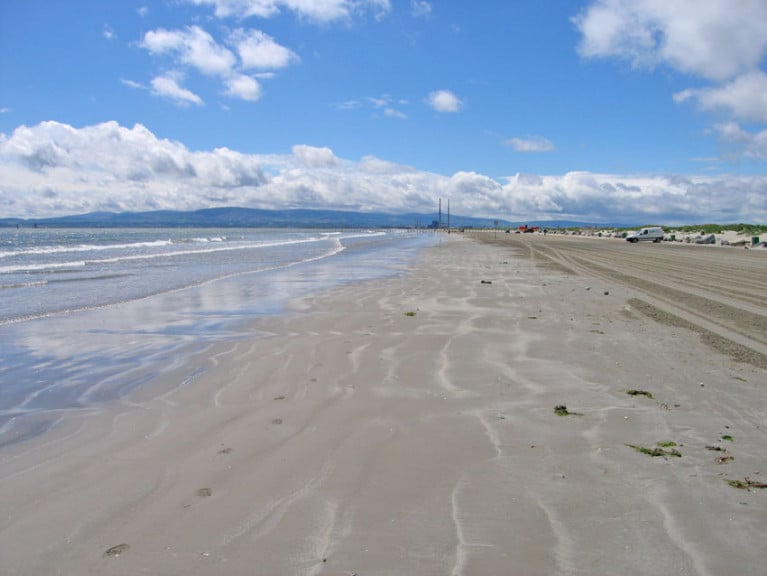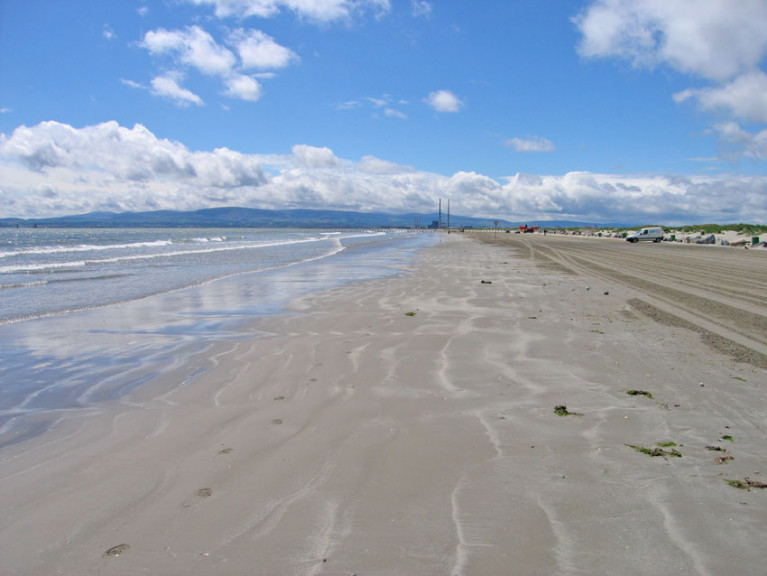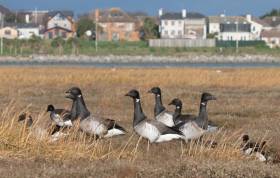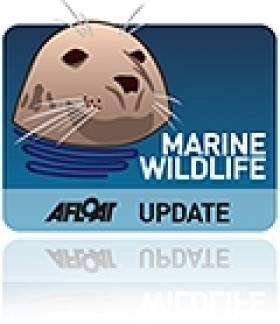Displaying items by tag: Bull Island
Mysterious Blue Balls Washed Up on Dublin Beach Prompt Concern
Small blue balls found on a North Dublin beach have prompted concerns around their origin and whether they pose a threat to a protected habitat, as the Irish Times reports.
Brian Bolger — who lives near Bull Island — says he has reported increasing numbers of the 25mm rubber-like spheres, both blue and orange, washing up on the island’s Dollymount Strand.
“We thought they were golf ball innards because there are two courses on the island,” he says.
But he later discovered that similar objects washed on an English beach were traced back to a nearby nuclear power station.
Those objects, known as Taprogge balls, are used in the cleaning process for cooling systems in power stations and other industrial processes.
It’s not yet confirmed if the balls found on Dollymount are of the same type, but their presence within the Dublin Bay Biopshere prompts concern for their potential to affect a sensitive habitat for many marine wildlife species.
The Irish Times has more on the story HERE.
Man Dies After Getting Into Difficulty Kitesurfing at Dollymount Strand
RTÉ News reports that a man in his 30s has died after getting into difficulty while kitesurfing at Dollymount Strand on Dublin Bay this morning (Saturday 31 October).
It’s understood that the man was pronounced dead at the scene before his body was removed to the Mater Hospital.
‘Monster Clean-Up’ On North Bull Island This Sunday
The Dublin Bay Biosphere Youth Committee is holding a ‘Monster Clean-Up’ on North Bull Island this Sunday 27 October from 2pm.
Get into the spooky spirit in this Hallowe’en-themed coastal litter pick-up event, and all taking part will be entered into a prize draw to win a family pass to Dublin Zoo.
All ages are welcome to join in — especially in costume — with all equipment provided as well as hot drinks for what will probably be a chilly day on Dublin Bay.
For more follow the hashtags #MonsterClean and #BiosphereYouth on Twitter and Instagram.

Celebrate The Return Of Light Bellied Brent Geese To Dublin Bay
#DublinBay - Dublin City Council will be hosting an open day on North Bull Island this Saturday 11 November 2017 from 10am till 4pm to celebrate the return of the light bellied brent goose to Dublin Bay.
The event, held part of the Annual Brent Goose Ambassador Project/Dublin Urban Birds Project, will feature family-friendly illustrated talks, guided identification of waders in the wild and interactive displays.
The light bellied brent goose is a protected species under wildlife legislation and is listed as amber among the Birds of Conservation Concern in Ireland. You can help with their conservation by participating in this citizen science day.
The schedule is as follows:
- Visitor Centre (10am, 11am, noon and 2pm): Illustrated talk by DCC's biodiversity officer on ‘the amazing story of the survival and migration of the light bellied brent goose and how it is estimated to fly over 50,000km per year on a plant diet even though it only weighs about 2kg.’
- Visitor Centre (10am till 4pm): Interactive exhibition on the Brent Goose Ambassador Project, and how the children of Dublin have stood up for their goose and Dublin Bay Biosphere.
- Causeway (10am, 11am, noon and 2pm): View the geese and other winter waders using scopes and binoculars and with expert instruction from BirdWatch Ireland.
Full details of the day are available from the Dublin City Council website HERE.
Irish Seal Sanctuary Calls for Bull Island Dog Ban
The Irish Seal sanctuary (ISS) is calling on the public to be vigilant and keep dogs away from seals on Bull Island. Bull Island and Dublin Bay is a biosphere reserve unique to the capital city and is home to both species of seals. Despite the strongest protection and designation available in law, breeding seals are subject to daily harrassment and disturbance, mainly by dogs. To date this harrassement has led seals to abandon their pups prematurely and two newborn pups are known to have died so far.
The ISS is calling on Dublin City Council (DCC) and the National Parks and Wildlife Service (NPWS) for an immediate dog ban on Bull Island untill the completion of the seal breeding.
Authorities are promising consultation, signage, trained voluntary guides and dog walking zones. This is all most welcome, however the seals are vulnerable now and if this level of harassment continues may disappear from the island. Several notable species, including terns and hares have already been lost, says ISS spokesman Brendan Price.
Grey Seals, the world's first protected species, residents of Dublin Bay and ubiquitous around the Irish coast are breeding now and during this time are very vulnerable to disturbance. Female seals require quiet shore space and breeding beaches to give birth. Thereafter females nurse their pups ashore for about 3 weeks. This is a period of the seal lifecycle that can only happen on land and while fascinating to watch, the golden rule is to observe from a distance.
Around the Irish coastline, this great wildlife spectacle is enjoyed and progresses undisturbed, however areas such as Bull Island are under increasing pressure from dogs and some walkers.
It is a great tribute to sensitive walkers and dog walkers, who avoid disturbance and some colonies are known to survive close to human habitation. Nevertheless evidence suggests that it only takes a few disturbances to drive seals away.
Bull Island, where the above photo is taken, is an especially sensitive area, unique also as host to both species of Irish seals, hauling out, feeding and breeding within the boundaries of the Capital city.
The Island a UNESCO Biosphere of long standing, now extended to the boundaries of Dublin Bay has sadly already lost breeding colonies of Terns and Hare. Two newborn, whitecoat, pups from island have died within the last month and post mortem analysis at the School of Veterinary Medicine, UCD, suggests abandonment and predation as the cause of death.
The DCC in response to these records is discussing improved signage, zonation, voluntary island guides etc., however in the meantime the seals remain vulnerable, the rangers and island are under resourced and the threat of losing this remarkable colony remains high.
The Bull Island is a stark but not unique case with Bailey and Doldrum Bay, outside Howth, abandoned by seals almost 100 years ago. These areas are still host to occasional pups, and walkers have recently been observed climbing down to a pup to take pictures and in another incident, misguidedly, throwing a pup into the water. Limekiln Bay and Brittas Bay have very vulnerable mothers birthing in the path of walkers and the pattern repeats coastwide.
The common seals, which bred earlier, are less vulnerable to threats from land as pups take to water on tide. Nevertheless, recreational users should be aware of their presence as these pups get separated from mothers by power boats, jet skis etc.
Litter, debris, waste can cause horrific injuries and usually result in death before affected animals can be caught and given veterinary help.
The message for today, according to Price, is do not disturb resting seals and do not create seal orphans (the endearing whitecoats) for rehabilitation when seal mothers can do a far superior job of nursing and rearing.
#Kitesurfing - It's Battle for the Bay time on Dollymount Strand this weekend (23-24 May), and The 42 brings us a preview of the kitesurfing action you can expect on Bull Island today and tomorrow.
Cheering on the competitors from the beach will be Irish medal winner Jade O'Connor, who's currently campaigning for a spot at a future Olympics when the sport makes its debut (potentially at Tokyo 2020).
And in her role as ambassador, O'Connor also has high praise some of the other action in Dublin Bay's waters, via the related discipline of boardercross – essentially kitesurfing on an obstacle course – and the crowd-pleasing freestylers.
“It’s really visual and it’s about jumping really high, like up to 20 metres in the air and doing tricks,” says the current British Ladies Champion.
The 42 has more on the story HERE.
Dublin Port to Give Bull Island Lands to Dublin City Council with additional €1.2m Towards New Facilities
#bullisland – Dublin Port Company today announced a proposal to transfer its ownership of a significant and strategic portion of Bull Island to Dublin City Council to hold in perpetuity for the people of Dublin and future generations.
Dublin Port Company will also partner with Dublin City Council and Fáilte Ireland in a feasibility study for a new interpretative centre and international visitor experience at the UNESCO designated Bull Island biosphere, and will contribute towards the development of a master plan for Bull Island following the conclusion of the study. In addition, Dublin Port Company will allocate up to €1.2 million towards the cost of the study, master plan and new services or facilities identified for Bull Island.
Dublin Port Company owns a portion of Bull Island closest to the port and adjacent to the Royal Dublin Golf Club measuring approximately 10.5 hectares, and located at the western side of the island beside the North Bull Wall. At present, the lands owned by Dublin Port Company are used for recreation, including gaining access to Dollymount Strand, thus providing an important link to the rest of Bull Island.
Bull Island was originally created following port engineering works in the 1800s; the construction of the Great South Wall and North Bull Wall resulted in the creation of Bull Island as it is known today.
The proposal will provide a legacy that enriches Bull Island as a precious natural resource for Dubliners and visitors to the City and has been welcomed by the Minister for Transport, Tourism & Sport Leo Varadkar and Dublin City Council. The proposal will be included as a community gain element to Dublin Port Company's planning application to provide new and deeper berths in the Alexandra Basin and on the river towards the east of Dublin Port. This is the first significant project for development under the company's Masterplan, which provides the framework for the future development of Dublin Port to 2040.
Minister for Transport, Tourism and Sport, Leo Varadkar said: "I commend Dublin Port for this initiative and for its ongoing contribution to the city both as an economic force and as the custodian of our river and bay. Dublin Port's gift to the people of Dublin will be welcomed by all and remembered for generations."
Eamonn O'Reilly, Chief Executive, Dublin Port Company said: "Dublin Port Company has a long tradition of developing and supporting projects which benefit local communities, the City of Dublin, its citizens and visitors. The Bull Island community gain initiative is an important element of our first major Masterplan project. This project will deliver more than three kilometres of new deeper berths for passenger, freight and cruise ships, all within the Port's existing footprint. Dublin is Ireland's cruise capital with more than 100 cruise ships calling this year. The project will allow the largest cruise ships to berth right up at East Link Bridge. An important part of the project is the community gain proposal to transfer ownership of Dublin Port Company's land holding in Bull Island to Dublin City Council and for Dublin Port Company to contribute funding towards new facilities that will attract local and foreign visitors to Bull Island. We are commencing a consultation exercise on this proposal and we look forward to hearing everyone's views."
Welcoming the proposal, Owen P Keegan, Dublin City Manager, Dublin City Council, said: "The City Council welcomes this valuable contribution from Dublin Port Company to the conservation and enhancement of the Bull Island. The Island is designated by UNESCO as a Biosphere reserve and it is a unique resource for the City. A feasibility study is being carried out to consider the potential for redeveloping the Visitor Centre on the island as a flagship project for natural heritage interpretation. This project and the on-going conservation of wildlife on the island will be much strengthened by this new partnership with Dublin Port Company."
Under its Masterplan, Dublin Port Company committed to maximise the utilisation of the port's existing berths and lands. The reconfiguration of Alexandra Basin will deliver on this commitment and will provide deeper berths to service larger freight, passenger and cruise ships in the years ahead.
Dublin Port Company is encouraging the local and wider Dublin communities to share their views on the 'community gain' proposal for Bull Island by Friday, 18th October 2013. Specific questions to guide submissions can be found at: www.dublinportabr.ie Interested parties are invited to make their submissions to [email protected] or Charlie Murphy, Dublin Port Company, Alexandra Road, Dublin 1.
Basking Shark Carcass Beached On Dollymount Strand
#MarineWildlife - The carcass of a large basking shark has washed up and is decomposing on Dollymount Strand in North Dublin, as The Irish Times reports.
The gentle giant - one of the second largest species of fish in the world's oceans - was beached early yesterday (15 July) after being sighted floating in the River Liffey.
Dublin City Council said it was making plans to remove the carcass from the popular seaside spot on Bull Island.
Human Leg Found on Dollymount Strand
#DUBLIN BAY NEWS - Investigations are underway after a human leg was discovered on a beach in north Dublin yesterday morning.
RTÉ News reports that the body part was found along Dollymount Strand on Bull Island around 9am yesterday (19 October) - some 18 months after a human arm was discovered on the same beach.
The State Pathologist's Office has been notified.
Stunning Photos of Kitesurfing in Dublin Bay
#KITESURFING - Photographer Luis Faustino has captured some stunning shots of Dublin kitesurfer Rob Clarke in action off Dollymount Strand.
"Dublin is quite windy, especially near the sea, in the bay," writes Faustino. "It's natural to see kitesurfers in many places and one of my favorite spots is Bull Island."
Find more of Luis Faustino's Dublin Bay kitesurfing photos HERE.


























